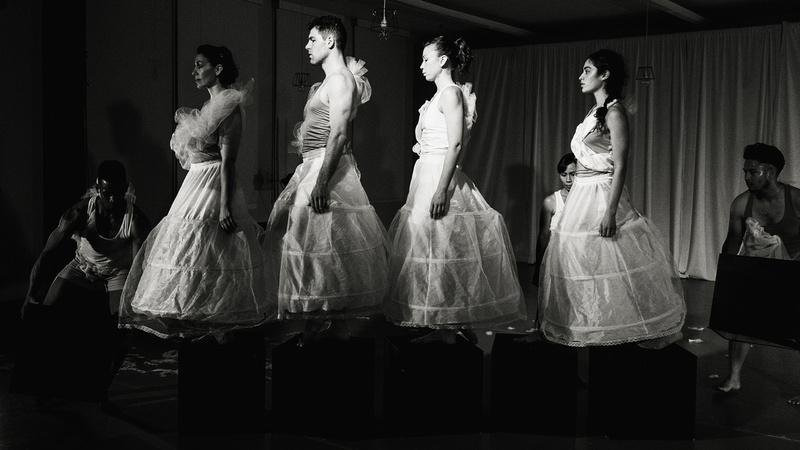Holding on to Life in Breathy ‘Dying Swan’ Revisited
With its emotional images of a swan-like dancer fluttering and collapsing, The Dying Swan has enthralled audiences for more than 100 years.
Mikhail Fokine created the solo for Russian ballerina Anna Pavlova, and she performed it thousands of times. On her death bed, she clutched her swan costume and asked to hear the music by Camille Saint-Saens.
Her painful dance is so famous, the all-male company Les Ballets Trockadero de Monte Carlos includes a satirical version with spindly legs, final gasps, and feathers dropping as if the old bird is molting.

The cast of “The Dying Swan: Revisited/Re-envisioned” presented by youTurn Arts. Image: Jim Carmody.
The Dying Swan: Revisited/Re-envisioned is a compelling new version, a breathy holding on to life drama presented by Erica Buechner and YouTurn Arts at the White Box this weekend.
Buechner expands Pavlova’s three minute solo into an evening-length work for seven dancers.
Live music greets the audience and helps connect ideas of old and new. Kristopher Apple plays violin and Harmony Negrin plays a gleaming gold harp. Their interpretation slips into minor keys to foreshadow ominous dancing. Dina Apple inserts the words “tick – tell” to remind us that time on this earth is short. Don’t miss this chance to sit a few feet away from a harp and experience the vibration of each pluck.
Like Pavlova, Buechner draws inspiration from birds and Tennyson’s poetry. She dedicates the work to her grandmother who is failing at the age of 94. The swan remains a metaphor for death.
Seven dancers appear in shadow on their backs and rise and fall in unison. We recognize arms undulating and hands fluttering from the wrist. They move strangely on half-toe, and we can imagine Pavlova a century ago.
But Michael Wall’s score is a strange and background hum. Pulsing turns to a gong signaling the end is near. This strong ensemble expands the life and death scenarios. At times they move as soldiers in battle. A few disappear behind a curtain, leaving three to march with quick feet popping off the floor. It’s as if the ground is too hot, a flash to movement from the original solo.
Dancers are also listed as collaborators: Ron Davis, Ian Isles, Christine Marshall, Sandra Ruiz, Lara Segura, Rachel Torres, and David Wornovitzky. Costumes are ragged scraps of netting and fabric, stitched by Anne Gehman, a youTurn Arts co-founder.
The end of life feeling is reinforced when dancers try to rise from the floor. They roll from side to side and rise in contractions as if it’s their last breath. A few feathers blow in like dried autumn leaves. A duet suggests memories of a young couple and losing a partner. There are only a few lifts and they are not fully realized.
There is a strong sense of wanting to escape death, but also to embrace that final sleep. In a final scene, dancers leave the earth. Dressed in giant white skirts, they line up to tip toe onto black risers. They must step forward without knowing if the black riser is there. We are left to consider the fragility of life and our own mortality.
http://youturnarts.com/

Kris Eitland covers dance and theater for Sandiegostory.com and freelances for other publications, including the Union Tribune and Dance Teacher Magazine. She grew up performing many dance styles and continued intensive modern dance and choreography at the Univ. of Minnesota, Duluth, and San Diego State Univ. She also holds a journalism degree from SDSU. Her career includes stints in commercial and public radio news production.
Eitland has won numerous Excellence in Journalism awards for criticism and reporting from the San Diego Press Club. She has served on the Press Club board since 2011 and is a past president. She is a co-founder of Sandiegostory.com. She has a passion for the arts, throwing parties with dancing and singing, and cruising the Pacific in her family’s vintage trawler. She trains dogs, skis, and loves seasonal trips to her home state of Minnesota.
